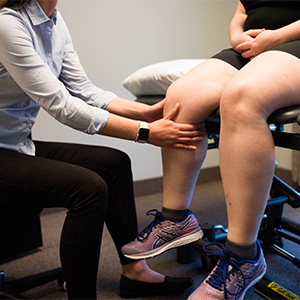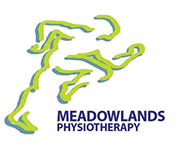Orthopedic and Sports Injuries
Get back into the swing of things with sports physiotherapy. Watching the game-winning goal from the sidelines instead of scoring it can be frustrating, but rushing back from an orthopedic or sports injury before you have fully healed can be dangerous, and end up keeping you out of the game for even longer.
Visiting a physiotherapist to get back into the game sooner, and help prevent future injuries from taking you back to the sidelines.
Sports and orthopedic injuries
Not everyone who plays sports will end up with a major orthopedic injury, and not every injury is caused by playing sports. But sports, especially contact sports, are one of the leading causes of orthopedic injury. Other common causes of injury include:
- Slips and falls
- Vehicle accidents
- Workplace injuries
- Pedestrian or cycling accidents

What are orthopedic injuries?
Orthopedic injuries include any damage or pain in your musculoskeletal system, which includes, bones, ligaments, joints, tendons, nerves, and muscles. Orthopedic injuries can range from a sprained ankle, to a broken arm.
Some of the most common types of orthopedic injuries are:
- Neck and back injuries
- Shoulder injuries
- Spinal injuries
- Pulled muscles
- Fractures or breaks
- Ligament injuries (e.g. torn anterior cruciate ligament)
- Dislocated shoulder
Recovery times from these types of injuries are as varied as the injuries themselves. A small sprain may resolve itself in a matter of weeks, but a serious injury to major joints like your hips, shoulders, or knees, can take months or years to fully heal. Even when, or if, serious injuries fully heal, patients often experience reduced strength, continued discomfort, chronic pain, and limited mobility.
The goal of physiotherapy is to reduce your recovery time and long-term discomfort while increasing your strength and mobility.
What is sports physiotherapy?
Athletes at all levels place their body under higher levels of stress to consistently achieve high levels of performance. Whether competing against another team, or yourself - placing strain on bones, muscles, and joints can lead to injury.
Each sport comes with its own risks, and knowing how to prevent and treat these different injuries for the optimal outcome for each type of sport is a vital part of a sports physiotherapist’s job.
Types of sports injuries
Broadly speaking there are three primary types of sports injuries that require physiotherapy:
Acute sports injuries caused by sudden impacts, tears, or strains. Common acute sports injuries include broken bones, torn ligaments, or spinal injuries.
Overuse injuries result from insufficient rest period between activity, causing injuries to joints, muscles, and even bone. These injuries may not manifest as dramatically as acute injuries but they can be just as, or even more debilitating.
Chronic injuries can result from acute injuries which fail to heal properly, or through long term overuse. Injuries can be categorized as chronic if it is repetitive, recurring, or long lasting.
Common Soccer Injuries
Each sport has common acute, overuse, and chronic injuries associated with it. In terms of participation, soccer is the most popular sport in Canada, one that results in common sports injuries, including:
- Acute injuries like sprains and strains to the legs
- Overuse from running can cause shin splints, patellar tendinitis (knee pain), Achilles tendinitis (pain in the Achilles tendon), and stress fractures
- Chronic injuries often develop from acute injuries which do not heal fully. In soccer, hamstring injuries often become chronic due to overuse, insufficient recovery, and high demands placed on the lower body.
Common Hockey Injuries
Hockey, on the other hand, results in many more upper body injuries caused by direct trauma. Checks, collisions with players and the boards, and blows from the puck and sticks are all common causes of trauma injuries, which may require rehabilitative physiotherapy. Strains, sprains, over-training and muscle injuries are also extremely common.
Preventative Physiotherapy
Physiotherapy can not only help you avoid sports and orthopedic injuries, it can help prevent them from occurring in the first place. Preventative sports physio builds the mobility, flexibility and strength that people of all ages and levels of activity need.
Related treatments
Pairing physiotherapy with massage, Pilates, or yoga is an excellent way to aid in preventing and recovering from sports and orthopedic injuries. Athletes who work hard in the gym and in practice can benefit from massage, which reduces muscle soreness and recovery time. Physiotherapy, Pilates, and Yoga can all increase strength, balance, flexibility and mobility, which is vital for all athletes.
Concussion management
Concussions are perhaps the highest profile sports injuries. Resulting from trauma to the brain caused by a blow to the head or neck, a concussion can result in permanent brain damage if it is not treated properly and as soon as possible. Although concussions do qualify as a sports injury, it is always best to see a doctor due to the severe risk associated with concussions. At Meadowlands Physiotherapy, our concussion management physiotherapist, Laura Baillie has received specialized training to treat concussions.
What should you expect at your first visit?
During your first visit you’ll undergo a personalized evaluation that will cover:
- Your medical history and any relevant medical conditions that your physiotherapist should know about
- Your current injury or issue
- Any pain or discomfort relating to your injury
- Your goals and expectations
After your evaluation, your physiotherapist will work with you to create a personal physio plan designed to help you reach your goals. This may include:
- The number of visits you need per week or month
- How long it will take to expect to see improvement or to recovery (in days, weeks, months, or years)
- Your goals
- And what to expect moving forward.
Treatment sessions themselves generally last from 30 minutes to an hour. You should wear athletic clothing that doesn’t restrict your movement. Most health insurance plans cover physiotherapy, so be sure to bring your insurance coverage with you on your first visit.
Physiotherapy for orthopedic and sports injuries in Ancaster
Meadowlands Physiotherapy in Ancaster offers comprehensive physiotherapy for sports and orthopedic injuries, including a holistic approach to treatments including Pilates, yoga, acupuncture and massage. With time and dedication, Meadowland’s highly skilled professional team will get you off of the sidelines and back into the game for good!
FAQs
(1) What are the top 5 Most Common Sports-Related Orthopedic Injuries?
- Pulled Muscle.
- Tennis Elbow.
- Ankle Sprain
- Shoulder Injury
- Runner’s knee
(2) What are sports injuries?
Sports injuries are often caused by overuse, direct impact, or the application of force that is greater than the body part can structurally withstand. Common injuries include bruises, sprains, strains and joint injuries.
Explore More on Orthopedic and sports injuries
Knee Pain: What to Do, What to Avoid
At some point in your life whether at work, while performing your sport, running, or even just headed up the stairs,...
Read PostPhysiotherapy for Runners
Humans are made to run. Anyone who competes as a runner, or who runs in their sport, likely feels this on a primal level....
Read PostHow Physiotherapy Can Help to Prevent Golf Injuries
While golf may look like a sport that is not that physically demanding, the truth is that it takes a lot of energy to...
Read PostHealth Prevention: Include Physiotherapy in Your Wellness Routine!
The wellness movement has changed the lives of millions of Canadians. Thanks to wellness awareness, we care more than...
Read Post



